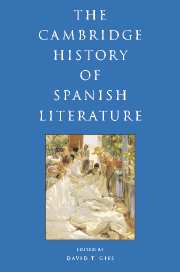Book contents
- Frontmatter
- I INTRODUCTION
- II HISTORY AND CANONICITY
- III THE MEDIEVAL PERIOD
- IV EARLY MODERN SPAIN: RENAISSANCE AND BAROQUE
- V THE ENLIGHTENMENT AND NEOCLASSICISM
- VI THE FORGING OF A NATION: THE NINETEENTH CENTURY
- VII THE MODERN, MODERNISMO, AND THE TURN OF THE CENTURY
- VIII TWENTIETH-CENTURY SPAIN AND THE CIVIL WAR
- IX IN AND OUT OF FRANCO SPAIN
- 46 The literature of Franco Spain, 1939–1975
- 47 Twentieth-century literature in exile
- 48 Prose in Franco Spain
- 49 Poetry in Franco Spain
- 50 Theatre in Franco Spain
- 51 Film and censorship under Franco, 1937–1975
- X POST-FRANCO SPANISH LITERATURE AND FILM
- Bibliography
- Index
- References
51 - Film and censorship under Franco, 1937–1975
from IX - IN AND OUT OF FRANCO SPAIN
Published online by Cambridge University Press: 28 March 2008
- Frontmatter
- I INTRODUCTION
- II HISTORY AND CANONICITY
- III THE MEDIEVAL PERIOD
- IV EARLY MODERN SPAIN: RENAISSANCE AND BAROQUE
- V THE ENLIGHTENMENT AND NEOCLASSICISM
- VI THE FORGING OF A NATION: THE NINETEENTH CENTURY
- VII THE MODERN, MODERNISMO, AND THE TURN OF THE CENTURY
- VIII TWENTIETH-CENTURY SPAIN AND THE CIVIL WAR
- IX IN AND OUT OF FRANCO SPAIN
- 46 The literature of Franco Spain, 1939–1975
- 47 Twentieth-century literature in exile
- 48 Prose in Franco Spain
- 49 Poetry in Franco Spain
- 50 Theatre in Franco Spain
- 51 Film and censorship under Franco, 1937–1975
- X POST-FRANCO SPANISH LITERATURE AND FILM
- Bibliography
- Index
- References
Summary
Film censorship existed in Spain long before the Nationalist government in Burgos established the first Junta Superior de Censura Cinematográfica (“Supreme Film Censorship Board”) in 1937. The earliest controls on film exhibition date back to 1913 when the Civil Governor of Barcelona denied public exhibition rights to films that offended public morality. In 1931, the Second Republic formalized its own approach to film exhibition by decentralizing the censorship activity and giving provincial governors broad authority to determine which films could or could not be shown.
Continuing what was by then a decades-old tradition of censorship and suppression of motion pictures, a ministerial order of 2 November 1938 expanded Francoist censorship bureaucracy by authorizing a companion Comisión Nacional de Cinematografía (“National Commission on Film”) to the Junta Superior it had established the year before. Whereas the Junta Superior had jurisdiction to review newsreels and documentaries produced by the government, the new board reviewed commercially produced fiction films prior to their distribution. The advent of this elaborate censorship machinery clearly reflected the propagandistic potential that Franco and his Minister of the Interior, Ramón Serrano Suñer, saw in motion pictures. From the start, the Burgos government recognized the need to counter the propaganda campaign in documentaries and newsreels already deftly managed by their Republican adversaries. Now, however, the arrangement for the twin censorship board – the Junta Superior de Censura and the Comisión Nacional – suggested that motion pictures were assuming a more prominent ideological position in the Francoists’ design for postwar Spain.
- Type
- Chapter
- Information
- The Cambridge History of Spanish Literature , pp. 677 - 684Publisher: Cambridge University PressPrint publication year: 2005



